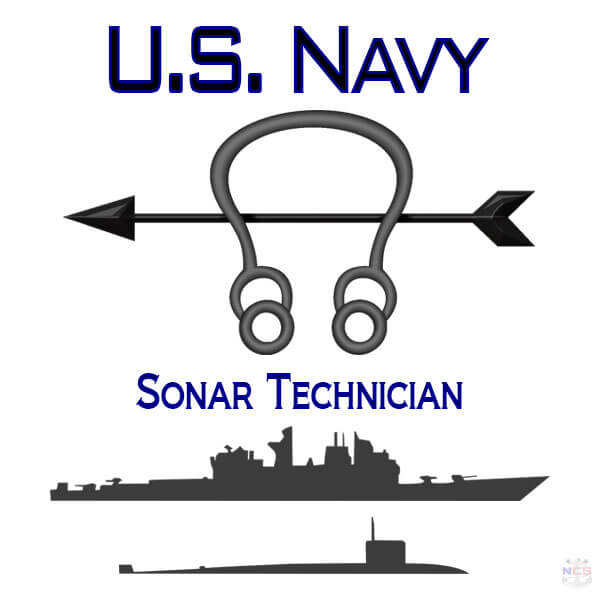The STG and STS Rating

Originally established as the Sonarman rating in 1943, the title was changed to Sonar Technician in 1964.
The Navy's computerized personnel system associates the rating name with an alphanumeric Navy Navy Enlisted Manning Code (EMC). For STG, the EMC is B340; for STS, C230.
Sonar Technicians are responsible for operating sonar systems, underwater fire control systems, and supporting equipment on surface ships such as frigates, destroyers and cruisers.
STs are also responsible for undersea surveillance, and aid in safe navigation and search-and-rescue operations. They use equipment to detect, analyze and locate targets of interest.
Sonar Technician (Surface) class "A" school is approximately 10 weeks long. The school is located in San Diego, California. Those a part of the Advanced Electronics Training will first complete a six week basic electronics course in Great Lakes, and after completion of the "A" school, they will attend class "C" school which could range between 27 to 58 weeks in San Diego, California. STG requires a four year (48 months) obligation, and if enlisted with the Advanced Electronics Field training, the total obligation required is six years (72 months).
Sonar Technician (Submarine) class "A" school is approximately 37 weeks in duration. The school is located in Groton, Connecticut.
Sonar Technicians, Surface job description (B340)
Sonar Technicians, Surface (STG) operate surface sonar and other oceanographic systems; manipulate, control, evaluate, and interpret sonar and oceanographic data. They operate surface ship underwater fire control systems (with associated equipment) for the solution of anti-submarine warfare problems, and perform organizational and intermediate maintenance on surface sonar and allied equipment.
Sonar Technicians, Submarine (C230)
Sonar Technicians, Submarine (STS) operate (control, evaluate, and interpret data) submarine sonar, oceanographic equipment, and submarine auxiliary sonar. They coordinate submarine sonar and underwater fire control interface, and perform organizational and intermediate maintenance on submarine and allied equipment.
Career Sea - Shore Rotation Chart
| Rating | SEA1 | SEA2 | SEA3 | SEA4 | SEA/SH |
|---|---|---|---|---|---|
| STG | 50 | 54 | 48 | 48 | 36/36 |
| STG (ATF) | 54 | 54 | 48 | 36 | |
| STS | 48 | 48 | 36 | 36 | |
| SH1 | SH2 | SH3 | SH4 | ||
| STG | 36 | 36 | 36 | 36 | |
| STG (ATF) | 36 | 36 | 36 | 36 | |
| STS | 36 | 36 | 36 | 36 |
Sea tours and shore tours for Sailors that have completed four sea tours will be 36 months at sea followed by 36 ashore until retirement.
Qualifications, Interests, and Working Environment
Sonar Technicians should have excellent hearing, an aptitude for electricity and electronics, skills in arithmetic, speaking and writing, the ability to do detailed work, keep records, and perform as a team member. They should also possess curiosity, resourcefulness, a good memory, and manual dexterity with tools, equipment and machines. The ability to do repetitive tasks and get along well with people is helpful.
STs must be U.S. citizens eligible for security clearances. Adversely adjudicated drug abuse offenses will not receive waiver consideration. Normal hearing and normal color perception are required. STs must have no speech impediments. They usually work indoors in a clean, comfortable shop-like environment and computer equipment rooms. They work closely with others and require little supervision.
Sonar Technicians may serve on surface craft (STG), or volunteer for submarine duty (STS). ST ASVAB Test score requirement.
Approximately 3,000 Sailors currently work in the Sonar Technician, Surface (STG) rating; and about 2,500 in the Sonar Technician, Submarine (STS) rating.
Personnel in the Sonar Technician rating are paid allowances (BAH, BAS, etc. if eligible) and billet pay (sea pay, submarine pay, etc. if eligible), and military basic pay based on years of service and paygrade.
Credit Recommendations
The American Council on Education recommends that semester hour credits be awarded in the vocational certificate or lower-division bachelor's/associates degree categories for courses taken in this rating on electricity and electronics, applied mathematics and blueprint reading.
Page written and maintained by NCCM Thomas Goering, USN (Retired).
If you are seeking information about joining the Navy, feel free to contact me.
